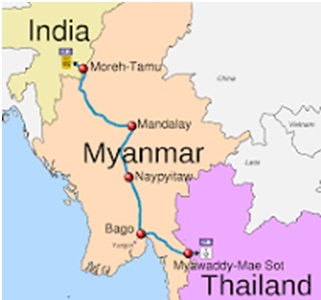|
Mains Exam
(General Studies Paper- 2 & 3: Bilateral, regional and global groupings and agreements involving India and/or affecting India's interests, Infrastructure: Energy, Ports, Roads, Airports, Railways etc.)
|
Context
- The Government of India is committed to the development of the eastern states including the northeastern states. Purvodaya Yojana has been announced for the eastern states in Budget 2024-25. Apart from this, schemes like 'PM-DIVINE' and 'Northeast Special Infrastructure Development Scheme’ (NESIDS)/ (Roads) are being run for the Northeast.
- India aims to transform its landlocked northeastern states into connectivity hubs with South and Southeast Asia as part of its ‘Act East’ policy vision.
- Establishment of mega connectivity projects and economic corridors is crucial to enhance trade, promote cultural exchange, contribute to regional stability and strengthen India’s strategic and geo-economic influence in Southeast Asia.
India-Myanmar-Thailand Trilateral Highway
- The India-Myanmar-Thailand Trilateral Highway (IMT-TH), spanning about 1360 km, aims to establish a seamless road connectivity between India, Bangladesh, Myanmar and Thailand.
- The highway starts from Moreh in Manipur, India, passes through Tamu and Mandalay in Myanmar and ends at Mae Sot in Thailand.
- The connectivity project promises substantial economic benefits by streamlining trade routes and promoting foreign investment.
- IMT-TH facilitates trade, education, tourism and health links between the three countries by providing more efficient and cost-effective transport routes.
- India's exports to ASEAN increased from US$ 42.32 billion in 2021-22 to US$ 44 billion in 2022-23.
- Imports reached US$ 87.57 billion in 2022-23 compared to US$ 68 billion in the previous year.

Benefits from India-Myanmar-Thailand Trilateral Highway
- Economic Outlook: Economic prospects can be boosted by making this highway a corridor connecting South Asia to South-East Asia.
- Inclusion of Bangladesh in this highway project will turn it into a comprehensive regional network.
- Increased integration: This will lead to further integration of the economies of the Bay of Bengal Initiative for Multi-Sectoral Technical and Economic Cooperation (BIMSTEC).
- This will increase access to markets of Nepal, Bhutan and other regions.
- Strategic Benefits: The IMT-TH projects are strategically important for India.
- It reflects India’s vision of deeper regional integration and establishing itself as an important stakeholder in Southeast Asian geopolitics.
- Foreign Policy Alignment: In line with India’s Act East Policy, the highway will enhance connectivity with Southeast Asia and promote cooperation by contributing to various other initiatives including the Asian Highway Network and the BIMSTEC Transport Master Plan.
- Cooperation through maritime connectivity: The highway will be supported by maritime connectivity efforts with MoUs already signed between Ranong Port in Thailand and Visakhapatnam, Chennai and Kolkata ports in India.
- Other benefits: Its completion will significantly reduce transportation costs and time. It will also be important to bridge geographical divides and meet the needs of the local community.
Challenges before the Tripartite Highway
Delay in completion of project
- Initially it was targeted to be operational by the year 2015. Later this deadline was extended to the year 2019.
- Currently the new deadline has been set for the year 2027.
- The main reason for this delay is political instability in Myanmar, financial issues and other regional obstacles.
Military coup in Myanmar
- The 2021 military coup and the rise of a junta government in Myanmar have crippled the project, exacerbating existing instability.
- The military’s grip on power has led to increased violence and widespread unrest, seriously impacting the safety of construction workers and travelers. The conflict has led to an unstable environment, disrupting project timelines and increasing risks.
- Conflict between the junta and ethnic armed groups continues to rage in Myanmar’s Chin State and Sagaing Region.
Ethnic conflict in Northeast India
- Ethnic conflict in India's Northeast is also a significant constraint. The highway is surrounded by several ethnic groups that have long been in conflict. This has complicated the construction and maintenance of the highway.
- Recent communal conflicts between the Kuki and Meitei communities in Manipur have further hampered the project's progress.
- For example, one of these constraints is the delay in the renovation of 69 bridges along the Tamu-Kaygon-Kalewa road.
Delay in implementation of Motor Vehicles Agreement
The formulation and implementation of the India-Myanmar-Thailand Trilateral Motor Vehicles Agreement (IMT-TMVA) is also a significant challenge. This is due to inadequate infrastructure, bureaucratic hurdles and security concerns.
Competition from Chinese infrastructure projects
Competition from Chinese infrastructure projects complicates regional cooperation and project implementation.
Other factors
- Myanmar's poor road network hinders smooth vehicular movement.
- Bureaucratic complexities in all three countries make obtaining necessary permits and approvals time-consuming.
- Security concerns in conflict-affected areas of Myanmar pose risks to the safe movement of vehicles and goods.
Tips for completing the project
- Addressing security challenges to ensure the safety of the highway and its users and to ensure the security of all stakeholders
- Increasing diplomatic engagement may be beneficial for this.
- Getting support from local communities for projects
- Collaborative efforts for capacity building and infrastructure development



